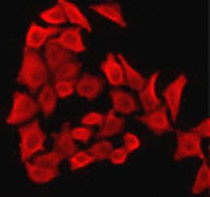ARG41126
anti-TGM3 / TGE antibody
anti-TGM3 / TGE antibody for ICC/IF,Western blot and Human,Mouse
Overview
| Product Description | Rabbit Polyclonal antibody recognizes TGM3 / TGE |
|---|---|
| Tested Reactivity | Hu, Ms |
| Tested Application | ICC/IF, WB |
| Host | Rabbit |
| Clonality | Polyclonal |
| Isotype | IgG |
| Target Name | TGM3 / TGE |
| Antigen Species | Human |
| Immunogen | Recombinant fusion protein corresponding to aa. 1-180 of Human TGM3 (NP_003236.3). |
| Conjugation | Un-conjugated |
| Alternate Names | Protein-glutamine gamma-glutamyltransferase E; E; Transglutaminase-3; TGE; TGase E; TGase-3; Transglutaminase E; TG; EC 2.3.2.13 |
Application Instructions
| Application Suggestion |
|
||||||
|---|---|---|---|---|---|---|---|
| Application Note | * The dilutions indicate recommended starting dilutions and the optimal dilutions or concentrations should be determined by the scientist. | ||||||
| Positive Control | BT474 | ||||||
| Observed Size | 72 kDa |
Properties
| Form | Liquid |
|---|---|
| Purification | Affinity purified. |
| Buffer | PBS (pH 7.3), 0.02% Sodium azide and 50% Glycerol. |
| Preservative | 0.02% Sodium azide |
| Stabilizer | 50% Glycerol |
| Storage Instruction | For continuous use, store undiluted antibody at 2-8°C for up to a week. For long-term storage, aliquot and store at -20°C. Storage in frost free freezers is not recommended. Avoid repeated freeze/thaw cycles. Suggest spin the vial prior to opening. The antibody solution should be gently mixed before use. |
| Note | For laboratory research only, not for drug, diagnostic or other use. |
Bioinformation
| Database Links |
Swiss-port # Q08188 Human Protein-glutamine gamma-glutamyltransferase E Swiss-port # Q08189 Mouse Protein-glutamine gamma-glutamyltransferase E |
|---|---|
| Gene Symbol | TGM3 |
| Gene Full Name | transglutaminase 3 |
| Background | Transglutaminases are enzymes that catalyze the crosslinking of proteins by epsilon-gamma glutamyl lysine isopeptide bonds. While the primary structure of transglutaminases is not conserved, they all have the same amino acid sequence at their active sites and their activity is calcium-dependent. The protein encoded by this gene consists of two polypeptide chains activated from a single precursor protein by proteolysis. The encoded protein is involved the later stages of cell envelope formation in the epidermis and hair follicle. [provided by RefSeq, Jul 2008] |
| Function | Catalyzes the calcium-dependent formation of isopeptide cross-links between glutamine and lysine residues in various proteins, as well as the conjugation of polyamines to proteins. Involved in the formation of the cornified envelope (CE), a specialized component consisting of covalent cross-links of proteins beneath the plasma membrane of terminally differentiated keratinocytes. Catalyzes small proline-rich proteins (SPRR1 and SPRR2) and LOR cross-linking to form small interchain oligomers, which are further cross-linked by TGM1 onto the growing CE scaffold (By similarity). In hair follicles, involved in cross-linking structural proteins to hardening the inner root sheath. [UniProt] |
| Cellular Localization | Cytoplasm. [UniProt] |
| Calculated MW | 77 kDa |
| PTM | Activated by proteolytic processing. In vitro activation is commonly achieved by cleavage with dispase, a neutral bacterial protease. Dispase cleavage site was proposed to lie between Ser-470 and Ser-471 (PubMed:8099584) or between Pro-465 and Phe-466 (PubMed:16565075). Physiological activation may be catalyzed by CTSL and, to a lesser extent, by CTSS, but not by CTSB, CTSD nor CTSV (PubMed:16565075). [UniProt] |
Images (2) Click the Picture to Zoom In







